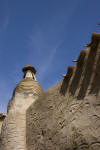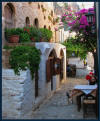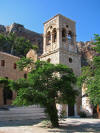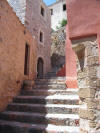Video's


MONEMVASIA,
(Greece)
means “single
entrance,” and as you cross the narrow bridge separating this fortified fist of
land from the southeast tip of the Peloponnesus,
you can see why Distanced from the ancient glories that unite much of Greece in a dream life of classical antiquity, the cyclamen-swept mile long rock at first looks wild. But follow the thin road edging along Monemvasia’s cliffs, past a sienna-tinged stone hotel and the small cemetery holding the bones of one of Greece’s most popular poets, Yannis Ritsos, born in the town in the early 20th century. Soon you will come to a spiked door of a fortress wall, behind which is a resilient town, rich with remnants of its reign as a main port during the Byzantine, Venetian and Ottoman empires.
Although only about a dozen people live year-around in Monemvasia’s old city today, compared with perhaps thousands during its 12th-century heyday, the town remains both magnetic to visitors and stubbornly ensconced in its past.
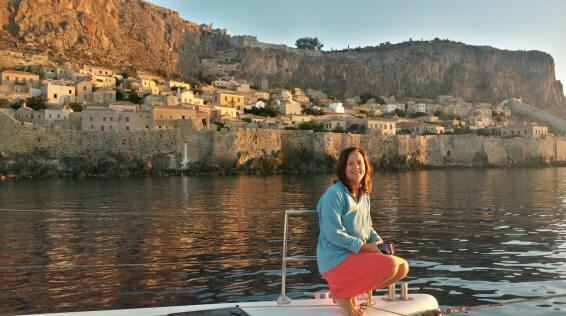 For folks in search
of an authentic slice of post-antiquity Greece, now is the time to visit
Monemvasia. Over the last three decades, this area has risen from modern
obscurity to become a popular holiday destination for Europeans and Americans. Monemvasia,
known colloquially as Kastro (castle or fortress), has resisted the urge to
trade its tradition for the lure of modernization, which has trammeled many
charming places in this history-rich country.
“We can’t change
Monemvasia; it would ruin everything,” said Matoula Ritsos, who has lived there
for more than 60 years and is, at 93, the oldest resident. “We weren’t supposed
to last here, in isolation and cut into a cliff of rock. But here we are.
Hundreds of years later, here we still are.”
For folks in search
of an authentic slice of post-antiquity Greece, now is the time to visit
Monemvasia. Over the last three decades, this area has risen from modern
obscurity to become a popular holiday destination for Europeans and Americans. Monemvasia,
known colloquially as Kastro (castle or fortress), has resisted the urge to
trade its tradition for the lure of modernization, which has trammeled many
charming places in this history-rich country.
“We can’t change
Monemvasia; it would ruin everything,” said Matoula Ritsos, who has lived there
for more than 60 years and is, at 93, the oldest resident. “We weren’t supposed
to last here, in isolation and cut into a cliff of rock. But here we are.
Hundreds of years later, here we still are.”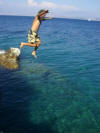 Folks
usually fall for
Monemvasia’s combination of nature and history, its serene view of the
velvet-blue Mirtoon Sea, its collection of quirky, open-hearted locals offering
a plate of amygdalota (almond cookies dusted with powdered sugar) or a glass of
Malvasia white wine.
Swim
in the clear water off the rocky beaches and hike through winding paths starred
with crimson blossoms, past the ruins of churches and mosques, to the abandoned
fortress at the crest of what historians called “the Gibraltar
of the East.” Under glittery night skies, there’s usually a late dinner of
octopus simmered in wine at one of the handful of taverns, followed by a swig of
brandy, ouzo or a honeyed homemade spirit called rakomelo at one of the
cliffside bars.
Folks
usually fall for
Monemvasia’s combination of nature and history, its serene view of the
velvet-blue Mirtoon Sea, its collection of quirky, open-hearted locals offering
a plate of amygdalota (almond cookies dusted with powdered sugar) or a glass of
Malvasia white wine.
Swim
in the clear water off the rocky beaches and hike through winding paths starred
with crimson blossoms, past the ruins of churches and mosques, to the abandoned
fortress at the crest of what historians called “the Gibraltar
of the East.” Under glittery night skies, there’s usually a late dinner of
octopus simmered in wine at one of the handful of taverns, followed by a swig of
brandy, ouzo or a honeyed homemade spirit called rakomelo at one of the
cliffside bars.
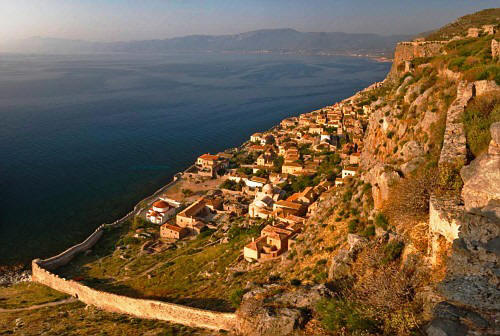 Monemvasia(pronounced Mo-nem-vah-SEE-ah) was most likely settled by the
residents of Sparta in the
Monemvasia(pronounced Mo-nem-vah-SEE-ah) was most likely settled by the
residents of Sparta in the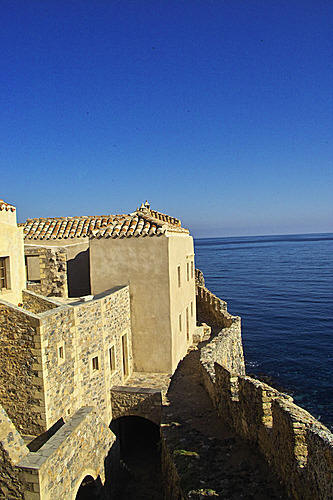 late sixth century after they fled barbarian invaders. They built homes and
churches on the far side of the rock along spiraling lanes, erected giant walls
along the lower city and around the fortress on the rock’s peak and crossed to
the mainland either through a wooden drawbridge or by wading through the shallow
waters. By 1193, Monemvasia was a major city in the Peloponnesus. Ships sailing
between Constantinople (now
Istanbul)
and what is now
Italy
stopped there, giving rest to aristocrats and high-ranking church members and
loading Greek exports like olive oil and wine headed for the West. Monemvasia
passed through Byzantine,
Vatican,
Frank, Venetian and Ottoman hands before becoming part of modern Greece.
late sixth century after they fled barbarian invaders. They built homes and
churches on the far side of the rock along spiraling lanes, erected giant walls
along the lower city and around the fortress on the rock’s peak and crossed to
the mainland either through a wooden drawbridge or by wading through the shallow
waters. By 1193, Monemvasia was a major city in the Peloponnesus. Ships sailing
between Constantinople (now
Istanbul)
and what is now
Italy
stopped there, giving rest to aristocrats and high-ranking church members and
loading Greek exports like olive oil and wine headed for the West. Monemvasia
passed through Byzantine,
Vatican,
Frank, Venetian and Ottoman hands before becoming part of modern Greece.
The upper town has been long abandoned. At turns luminous and menacing, depending on the brightness of the sun, it lies along the crests of the rock. A path of hairpin bends passes the ruins of once-majestic buildings and leads to Aghia Sophia (Holy Wisdom), a beautifully intact mid-12th-century Byzantine church with a sculptured door and marble reliefs. The highest peak in the upper town, accessible by climbing a trail of lush brush, is about 656 feet above sea level. Meanwhile, Monemvasia’s inhabited lower town has churned for centuries, thanks to its merchants and artisans.
“I consider what we do now an extension of what the merchants before us did,” said Maria Liavakou, 33, who owns a wine shop called To Kellari, which specializes, of course, in Malvasia wine. "
The lower town’s cobblestoned principal lane is lined with tall, slim earthy-stone houses with arched doorways and vaulted rooms. The narrower buildings have older foundations, while the wider buildings are newer, dating to the 18th or 19th centuries, and have modern touches like wrought-iron balconies. A bell tower is near the main square, which has the medieval Church of Elkomenos Christos (Christ Drawn to His Passion), a museum with artifacts from the town’s early years and an old cannon. Although merchants may have given Monemvasia’s lower town its immediacy, architects — namely a husband-and-wife team from Athens — helped save its identity. Since 1967, the couple, Alexandros and Haris Kalligas, who live here half the year, have been responsible for restoring more than half of the 160 properties on the rock. Their work on Monemvasia, which they are recording in a book, won them a Europa Nostra cultural heritage medal in 1980
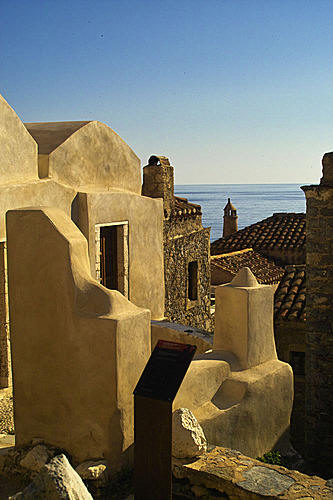 “One of
the reasons we believe there are so many old buildings here is that they were
very well-built,” said Ms. Kalligas, Monemvasia’s most noted historian.
“One of
the reasons we believe there are so many old buildings here is that they were
very well-built,” said Ms. Kalligas, Monemvasia’s most noted historian.
ON a recent evening, Magda Alisafou, who owns a small tavern in the lower town with her sister Marianthi, after whom the tavern is named, fried thick-cut potatoes and stirred a big pot of artichokes stewed with carrots and dill as she read the orders piling up on the counter. “When we first opened, there were only five people coming to the restaurant, and on many days the only voice you heard was the wind’s,” said Ms. Alisafou, who opened the tavern in 1970. At that time, the town was regenerating after losing most of its population during the Nazi occupation in World War II and the desolate years of the deeply divisive Greek Civil War that followed.
For now, the expansion of tourism-related development remains safely across the bridge in Gefira. With its back to the modern land, its face to the sun and the sea, Monemvasia thrives in its whimsy, alive in its lost world. “This place has survived on its identity, and once you see how real it is, you cannot forget it,” said Chrysafo Karkannis, a retired architect who was born in a nearby village but who grew up in Buenos Aires. She returned five years ago to rent a small studio on the rock and paint images inspired by its landscape.
The poet Yannis Ritsos also never forgot Monemvasia, even after he left for literary success in Athens. Jailed for his leftist beliefs before enjoying a resurgence in his later years, Ritsos was one of the most prolific poets of his generation. He died in 1990 and was buried in Monemvasia’s cemetery. His pompadoured bust stares at the sea from the courtyard of his childhood home in the lower town.
Ritsos’s verses, including the poem “Monemvasiotisses,” which was published in 1987 and is devoted to the town’s women, sometimes referred to his lonely rock with the single entrance. In its resilience, he celebrated freedom.
“So many years, besieged by mainland and by sea,” he wrote in his 1945 epic poem “Romiosini.” “They’ve all been hungry, all been killed, and yet — not a single one is dead.”
